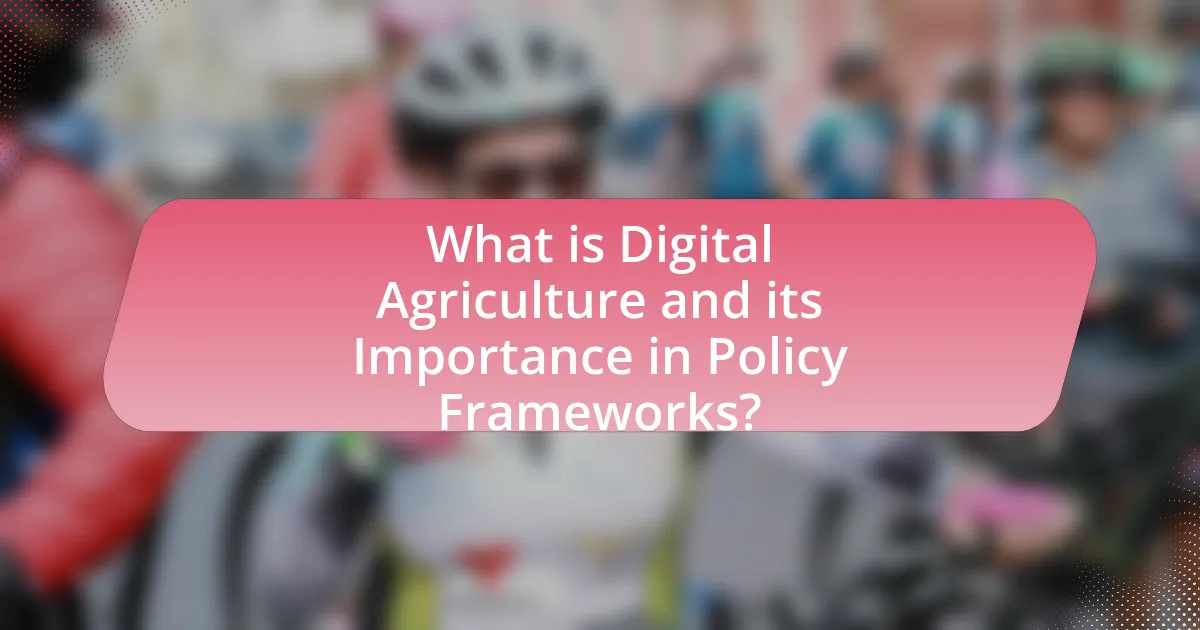Digital agriculture is the integration of digital technologies into farming practices aimed at enhancing productivity, sustainability, and efficiency. This article explores the significance of digital agriculture within policy frameworks, highlighting its potential to drive agricultural innovation, improve food security, and promote environmental sustainability. Key topics include the integration of digital tools with existing agricultural policies, the technologies involved, and the influence of these technologies on policy decisions. Additionally, the article addresses challenges faced by traditional farming, the role of data management, and the importance of stakeholder collaboration in developing effective policies that support digital agriculture and ensure equitable access to its benefits.

What is Digital Agriculture and its Importance in Policy Frameworks?
Digital agriculture refers to the integration of digital technologies into farming practices to enhance productivity, sustainability, and efficiency. Its importance in policy frameworks lies in its potential to drive agricultural innovation, improve food security, and promote environmental sustainability. For instance, the Food and Agriculture Organization (FAO) emphasizes that digital tools can optimize resource use and reduce waste, which aligns with global sustainability goals. Moreover, policies that support digital agriculture can facilitate access to data-driven insights, enabling farmers to make informed decisions that enhance crop yields and resilience against climate change.
How does Digital Agriculture integrate with existing agricultural policies?
Digital agriculture integrates with existing agricultural policies by enhancing data-driven decision-making and promoting sustainable practices. This integration occurs through the alignment of digital tools, such as precision farming technologies and data analytics, with policy objectives aimed at improving productivity, resource efficiency, and environmental stewardship. For instance, the European Union’s Common Agricultural Policy encourages the adoption of digital technologies to achieve its goals of sustainability and competitiveness in agriculture, demonstrating a clear policy framework that supports the integration of digital agriculture.
What technologies are considered part of Digital Agriculture?
Digital agriculture encompasses various technologies that enhance farming practices through data-driven decision-making. Key technologies include precision agriculture tools, which utilize GPS and IoT sensors to optimize field-level management; drones for aerial imaging and crop monitoring; big data analytics for processing agricultural data; and artificial intelligence for predictive analytics and automation. Additionally, blockchain technology is employed for supply chain transparency, while mobile applications facilitate real-time communication and information sharing among farmers. These technologies collectively improve efficiency, productivity, and sustainability in agricultural practices.
How do these technologies influence policy decisions?
Digital agriculture technologies influence policy decisions by providing data-driven insights that enhance agricultural productivity and sustainability. These technologies, such as precision farming tools and data analytics platforms, enable policymakers to make informed decisions based on real-time data regarding crop yields, resource usage, and environmental impacts. For instance, the use of satellite imagery and IoT sensors allows for better monitoring of agricultural practices, leading to policies that promote efficient resource allocation and environmental conservation. Studies have shown that regions implementing digital agriculture technologies have seen a significant increase in crop yields, which directly informs policy frameworks aimed at food security and rural development.
Why is it essential to explore Digital Agriculture in policy frameworks?
Exploring Digital Agriculture in policy frameworks is essential because it enables the integration of innovative technologies that enhance agricultural productivity and sustainability. Digital agriculture encompasses tools such as precision farming, data analytics, and IoT, which can significantly improve resource management and crop yields. For instance, a study by the Food and Agriculture Organization (FAO) indicates that adopting digital technologies can increase agricultural productivity by up to 30%. By incorporating these technologies into policy frameworks, governments can support farmers in adapting to climate change, optimizing inputs, and reducing environmental impacts, ultimately leading to a more resilient food system.
What challenges does Digital Agriculture address in traditional farming?
Digital agriculture addresses several challenges in traditional farming, including inefficiencies in resource management, limited access to real-time data, and difficulties in predicting crop yields. Traditional farming often relies on outdated methods that lead to overuse of water and fertilizers, whereas digital agriculture utilizes precision farming techniques to optimize resource use, resulting in a 20-30% reduction in water consumption and a 10-20% increase in crop yields, as reported by the Food and Agriculture Organization. Additionally, digital tools provide farmers with access to real-time weather data and market information, enabling better decision-making and risk management. This shift towards data-driven practices enhances productivity and sustainability in agriculture.
How can policy frameworks support the adoption of Digital Agriculture?
Policy frameworks can support the adoption of Digital Agriculture by establishing regulations that promote technology integration and providing financial incentives for farmers to adopt digital tools. These frameworks can facilitate access to funding, such as grants or low-interest loans, which encourage investment in digital technologies like precision farming and data analytics. For instance, the European Union’s Common Agricultural Policy includes measures that support digital innovation in agriculture, demonstrating how structured policies can lead to increased adoption rates. Additionally, policy frameworks can enhance infrastructure development, ensuring that rural areas have the necessary internet connectivity to utilize digital agriculture solutions effectively.
What are the key components of Digital Agriculture policies?
The key components of Digital Agriculture policies include data management, technology integration, infrastructure development, and stakeholder engagement. Data management ensures the collection, analysis, and sharing of agricultural data to enhance decision-making and productivity. Technology integration involves the adoption of digital tools such as precision farming, IoT devices, and AI to optimize agricultural practices. Infrastructure development focuses on improving connectivity and access to digital resources in rural areas, facilitating the implementation of digital solutions. Lastly, stakeholder engagement emphasizes collaboration among farmers, government agencies, and private sector players to create supportive policies and frameworks that foster innovation and sustainability in agriculture.
What role do data management and analytics play in these policies?
Data management and analytics are crucial in shaping policies related to digital agriculture by enabling informed decision-making and optimizing resource allocation. Effective data management ensures the collection, storage, and processing of agricultural data, which is essential for analyzing trends, monitoring crop health, and predicting yields. Analytics transforms this data into actionable insights, allowing policymakers to develop strategies that enhance productivity and sustainability. For instance, the use of precision agriculture technologies, which rely on data analytics, has been shown to increase crop yields by up to 20% while reducing input costs, demonstrating the tangible benefits of integrating data management and analytics into agricultural policies.
How do regulations impact the implementation of Digital Agriculture?
Regulations significantly impact the implementation of Digital Agriculture by establishing standards that govern technology use, data management, and environmental practices. These regulations can facilitate or hinder innovation; for instance, stringent data privacy laws may restrict the sharing of agricultural data, which is essential for optimizing farming practices. Additionally, compliance with safety and environmental regulations can require farmers to invest in specific technologies, influencing their adoption rates. According to a report by the Food and Agriculture Organization, regulatory frameworks that support digital tools can enhance productivity and sustainability in agriculture, demonstrating that effective regulations can drive the successful integration of digital solutions in farming.
How does Digital Agriculture influence sustainability in agriculture?
Digital agriculture significantly enhances sustainability in agriculture by optimizing resource use and reducing environmental impact. Through technologies such as precision farming, farmers can monitor soil health, water usage, and crop conditions in real-time, leading to more efficient application of inputs like fertilizers and pesticides. For instance, a study published in the journal “Agricultural Systems” found that precision agriculture can reduce fertilizer use by up to 30%, thereby minimizing runoff and pollution. Additionally, digital tools facilitate data-driven decision-making, which helps in implementing sustainable practices that conserve biodiversity and improve soil health. This integration of technology not only boosts productivity but also aligns agricultural practices with sustainability goals, demonstrating a clear link between digital agriculture and sustainable farming outcomes.
What practices promote environmental sustainability through Digital Agriculture?
Practices that promote environmental sustainability through Digital Agriculture include precision farming, data-driven decision-making, and the use of IoT devices. Precision farming optimizes resource use, reducing water and fertilizer consumption by applying them only where needed, which can decrease runoff and pollution. Data-driven decision-making leverages analytics to improve crop yields while minimizing environmental impact, as evidenced by studies showing that data utilization can lead to a 10-20% reduction in inputs. IoT devices, such as soil moisture sensors, enable real-time monitoring, allowing farmers to make informed decisions that enhance sustainability. These practices collectively contribute to more efficient resource management and reduced environmental degradation.
How can policies encourage sustainable practices in Digital Agriculture?
Policies can encourage sustainable practices in Digital Agriculture by providing financial incentives, establishing regulatory frameworks, and promoting research and development. Financial incentives, such as subsidies for adopting precision farming technologies, can lower the barriers for farmers to implement sustainable practices. Regulatory frameworks can set standards for sustainable practices, ensuring compliance and accountability among agricultural producers. Additionally, promoting research and development through grants and partnerships can lead to innovative solutions that enhance sustainability in digital agriculture. For instance, the European Union’s Common Agricultural Policy includes measures that support environmentally friendly farming practices, demonstrating the effectiveness of policy in driving sustainable agricultural practices.
What are the implications of Digital Agriculture on food security?
Digital agriculture significantly enhances food security by improving crop yields, optimizing resource use, and enabling better supply chain management. The integration of technologies such as precision farming, data analytics, and remote sensing allows farmers to make informed decisions, leading to increased productivity. For instance, a study by the Food and Agriculture Organization (FAO) indicates that precision agriculture can increase crop yields by 10-30% while reducing input costs by up to 20%. Furthermore, digital tools facilitate real-time monitoring of agricultural conditions, which helps in mitigating risks associated with climate change and pests, thereby ensuring a more stable food supply. These advancements contribute to a more resilient agricultural system, ultimately supporting global food security.
How does Digital Agriculture enhance food production efficiency?
Digital agriculture enhances food production efficiency by utilizing advanced technologies such as precision farming, data analytics, and automation. These technologies enable farmers to optimize resource use, improve crop yields, and reduce waste. For instance, precision agriculture employs GPS and IoT sensors to monitor soil conditions and crop health in real-time, allowing for targeted interventions that can increase productivity by up to 20% according to a study by the Food and Agriculture Organization. Additionally, data analytics helps in forecasting weather patterns and market trends, enabling better decision-making and resource allocation. This integration of technology leads to more sustainable farming practices and increased overall efficiency in food production.
What policies can ensure equitable access to Digital Agriculture technologies?
Policies that can ensure equitable access to Digital Agriculture technologies include targeted subsidies for smallholder farmers, investment in rural digital infrastructure, and the establishment of inclusive training programs. Targeted subsidies can lower the financial barriers for small-scale farmers, enabling them to adopt advanced technologies. Investment in rural digital infrastructure, such as internet connectivity and mobile networks, is crucial, as approximately 3.7 billion people globally lack internet access, which hinders their ability to utilize digital agriculture tools. Inclusive training programs can enhance digital literacy among farmers, ensuring they can effectively use these technologies; for instance, the Food and Agriculture Organization has reported that training initiatives can significantly improve technology adoption rates among marginalized communities.
How can stakeholders collaborate to enhance Digital Agriculture policies?
Stakeholders can collaborate to enhance Digital Agriculture policies by establishing multi-stakeholder platforms that facilitate dialogue and knowledge sharing. These platforms enable farmers, technology providers, policymakers, and researchers to exchange insights and best practices, ensuring that policies are informed by real-world needs and technological advancements. For instance, the Food and Agriculture Organization (FAO) emphasizes the importance of stakeholder engagement in policy formulation, highlighting that inclusive approaches lead to more effective and sustainable agricultural practices. By leveraging data analytics and digital tools, stakeholders can also identify trends and challenges in agriculture, allowing for timely policy adjustments that reflect the evolving landscape of digital agriculture.
What roles do government, industry, and academia play in policy development?
Government, industry, and academia each play distinct yet interconnected roles in policy development. Government establishes regulatory frameworks and policies that guide agricultural practices, ensuring compliance with safety, environmental, and economic standards. Industry contributes by providing technological innovations and practical insights that inform policy decisions, often advocating for regulations that support business growth and sustainability. Academia conducts research that generates evidence-based knowledge, offering critical analysis and recommendations that shape effective policies. For instance, studies from institutions like the Food and Agriculture Organization highlight how collaborative efforts among these sectors lead to more comprehensive and effective agricultural policies.
How can public-private partnerships strengthen Digital Agriculture initiatives?
Public-private partnerships can strengthen Digital Agriculture initiatives by leveraging resources, expertise, and technology from both sectors to enhance agricultural productivity and sustainability. These collaborations enable the sharing of innovative digital tools, such as precision farming technologies and data analytics, which can lead to improved crop yields and resource management. For instance, a study by the Food and Agriculture Organization (FAO) highlights that partnerships between governments and tech companies have successfully implemented digital platforms that provide farmers with real-time information on weather, market prices, and best practices, resulting in increased efficiency and profitability.
What best practices should be considered for effective Digital Agriculture policies?
Effective Digital Agriculture policies should prioritize stakeholder engagement, data interoperability, and investment in digital infrastructure. Stakeholder engagement ensures that the needs and insights of farmers, agribusinesses, and technology providers are incorporated, leading to more relevant and effective policies. Data interoperability facilitates seamless sharing and integration of agricultural data across platforms, enhancing decision-making and operational efficiency. Investment in digital infrastructure, such as high-speed internet and mobile connectivity, is crucial for enabling access to digital tools and resources, particularly in rural areas. These practices are supported by studies indicating that inclusive policy frameworks lead to higher adoption rates of digital technologies in agriculture, ultimately improving productivity and sustainability.
How can policymakers ensure inclusivity in Digital Agriculture initiatives?
Policymakers can ensure inclusivity in Digital Agriculture initiatives by implementing targeted programs that address the specific needs of marginalized groups, such as smallholder farmers and women. These programs should include access to affordable technology, training on digital tools, and financial support to facilitate participation in digital agriculture. For instance, the Food and Agriculture Organization (FAO) emphasizes the importance of gender-sensitive approaches in agricultural policies, highlighting that women represent a significant portion of the agricultural workforce but often lack access to resources. By integrating these considerations into policy frameworks, governments can create an equitable environment that empowers all stakeholders in the agricultural sector.
What metrics should be used to evaluate the success of Digital Agriculture policies?
The metrics used to evaluate the success of Digital Agriculture policies include productivity improvements, economic impact, adoption rates of digital technologies, environmental sustainability, and farmer satisfaction. Productivity improvements can be measured through yield increases per hectare, which indicate the effectiveness of digital tools in enhancing agricultural output. Economic impact can be assessed by analyzing changes in farm income and cost reductions due to technology adoption. Adoption rates of digital technologies, such as precision farming tools and data analytics, provide insight into how widely these innovations are embraced by farmers. Environmental sustainability metrics, including reductions in water usage and pesticide application, reflect the ecological benefits of digital agriculture. Lastly, farmer satisfaction surveys can gauge the perceived value and usability of digital solutions, ensuring that policies align with the needs of the agricultural community. These metrics collectively provide a comprehensive framework for assessing the effectiveness of Digital Agriculture policies.















